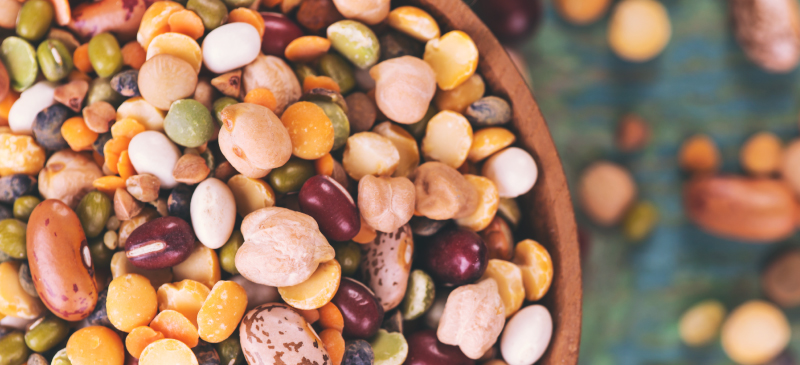What are legumes good for? Top 5 benefits of legumes

What Are Legumes?
So what exactly are legumes? Are legumes vegetables, beans, nuts or something else altogether? The official legumes definition is “the fruit or seed of plants of the legume family (such as peas or beans) used for food.” To put it simply, legumes include any fruits or seeds of plants in the Fabaceae family, which includes around 19,500 different species and 751 genera of plants. Beans, lentils, peanuts and peas are a few of the most common types of legumes that are consumed around the world.
Beans vs. Legumes
What is the difference between beans and legumes? Which beans are legumes, and are there any beans that are not legumes?
The biggest difference between legumes vs. beans is that not all legumes are beans, but all beans are considered legumes. This is because legumes are defined as the fruit or seed of plants in the Fabaceae family, which includes beans, lentils, peas and peanuts. Beans, on the other hand, are the seeds of several different plant varieties, including Phaseolus vulgaris (black bean), Glycine max (soybean) or Vigna angularis (adzuki bean). All of these plants belong to the Fabaceae family and are thus classified as legumes.
Nuts vs. Legumes
So are nuts legumes? Most types of nuts grow on trees and are considered tree nuts rather than legumes. For example, nuts such as almonds, walnuts, cashews and Brazil nuts are composed of a seed that is surrounded by a dry fruit and enclosed in a hard shell.
The only exception is peanuts. So are peanuts legumes? Unlike other types of nuts, peanuts actually grow underground and are a member of the Fabaceae family of plants, which classifies them as legumes.
Legumes List
There’s often a lot of confusion about which foods fall into the category of legumes. For example, are green beans legumes? Are peas legumes? Are lentils legumes? Here’s a list of legumes to help better define which common foods are classified as legumes:
Black beans
Navy beans
Kidney beans
Soybeans
Green beans
Pinto beans
Fava beans
Adzuki beans
Chickpeas
Alfalfa
Lentils
Peas
Peanuts
5 Benefits of Legumes
 |
1. Loaded with Nutrients
Legumes are a great source of several important nutrients, including a wide array of vitamins and minerals. Although the exact nutrient profile can vary for specific types of legume, most are generally high in folate, manganese, iron and magnesium, along with an assortment of other key micronutrients.
Legumes are also a great plant-based source of protein and fiber, both of which are important to several aspects of health. Protein, for example, is integral to immune function, body composition, tissue repair, and healthy growth and development. Meanwhile, fiber has been shown to reduce blood pressure, lower cholesterol levels, improve insulin sensitivity, enhance weight loss and more.
2. Stabilize Blood Sugar
One 2014 study published in the journal ARYA Atherosclerosis examined the dietary patterns of 2,027 people and found that regular consumption of legumes was linked to lower blood sugar levels. This is because legumes are high in fiber, which helps slow the absorption of sugar in the bloodstream to regulate blood sugar levels. Fiber also improves the body’s ability to use insulin more effectively, which is the hormone responsible for transporting sugar from the bloodstream to the cells.
3. Increase Weight Loss
Thanks to the legumes protein and fiber content, filling up on these superstar ingredients could also aid in weight loss. Fiber moves very slowly through the digestive system, which can reduce hunger and support weight control. Similarly, protein works to reduce levels of ghrelin, the hormone responsible for stimulating hunger, to help manage appetite and food intake. According to one study in the Journal of the College of American Nutrition, bean consumption may be associated with less belly fat, a lower body weight and a decreased risk of obesity.
4. Promote Heart Health
Legumes can reduce several risk factors of heart disease to help keep your heart healthy and strong. For instance, a large review conducted by the Tulane University School of Public Health and Tropical Medicine showed that consuming legumes can decrease levels of total and “bad” LDL cholesterol, both of which are major contributors to heart disease. It may also help reduce triglycerides, lower blood pressure levels and decrease several markers of inflammation to aid in heart health.
5. Enhance Digestive Health
Adding a few legumes recipes to your daily diet can bring big benefits when it comes to digestive health. In fact, research shows that upping your intake of fiber from foods like legumes can aid in the treatment and prevention of several issues, such as intestinal ulcers, perticulitis, hemorrhoids and gastroesophageal reflux disease (GERD). Fiber also helps add bulk to the stool, supporting regularity and protecting against constipation as well./.
( Rachael Link )
Recommended
 Handbook
Handbook
Vietnam Moves Up 8 Places In World Happiness Index
 Handbook
Handbook
Travelling Vietnam Through French Artist's Children Book
 Multimedia
Multimedia
Vietnamese Turmeric Fish among Best Asian Dishes: TasteAtlas
 Handbook
Handbook
From Lost to Found: German Tourist Thanks Vietnamese Police for Returning His Bag
Popular article
 Handbook
Handbook
Prediction and Resolution for the Disasters of Humanity
 Handbook
Handbook
16 French Films To Be Shown For Free During Tet Holiday In Vietnam
 Handbook
Handbook
Unique Cultural and Religious Activities to Welcome Year of the Snake
 Handbook
Handbook



